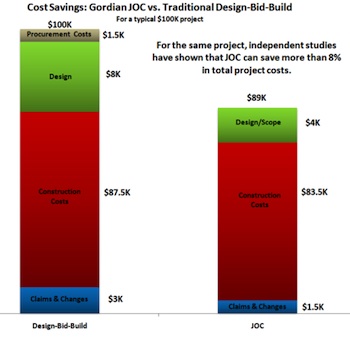Surviving Summer Break With JOC
 By Paul R. Schreyer, northeast regional manager for The Gordian Group Inc. Schreyer has 15 years of experience in developing job order contracting systems for schools, universities and other large facility owners, including the New York City Department of Education. He can be reached at p.schreyer@thegordiangroup.com.
By Paul R. Schreyer, northeast regional manager for The Gordian Group Inc. Schreyer has 15 years of experience in developing job order contracting systems for schools, universities and other large facility owners, including the New York City Department of Education. He can be reached at p.schreyer@thegordiangroup.com.
As students count down to summer vacation, administrators and facilities managers gear up for the construction season — an ideal time to complete projects such as bathroom renovations, ADA upgrades, classroom conversions, and the paint and flooring jobs that pile up over time. Now is the ideal time to prepare.
Many small- to medium-sized summer projects, such as parking lot repaving and ADA upgrades, may be too large for in-house staff, but not large enough to justify a complete design-bid-build cycle. One efficient, effective and flexible procurement method is the job-order contracting (JOC) process, which in my experience allows school officials to complete a large number of routine repair and renovation projects with a single, competitively bid contract.
Many school districts have hundreds of small- to medium-sized construction projects and no way to manage them, much less design, bid and award them. Under the JOC process, there is no need to design and bid each project individually. Instead, contractors bid an adjustment factor on a book of preset unit prices for a variety of construction tasks, such as a square foot of painting, a square foot of ceiling tile, chalkboards, doors, hardware, etc. Using accurate, locally developed prices makes contractors more comfortable with the contract and enables them to submit more competitive bids.
Depending on the owner’s bidding options, the JOC contract can go to the lowest responsive and responsible bidder or the contractor deemed to offer the best value. Once the contract is awarded, the owner can ask the contractor to perform a series of projects. For each, the contractor is simply paid the preset unit prices multiplied by the quantity, which is in turn multiplied by the competitively bid adjustment factor. Once a project is identified, the contractor and school officials meet at the job site to conduct a joint scope meeting, where the contractor can see, touch and understand all aspects of the job.
There are advantages to conducting joint scope meetings and pricing projects through the JOC process. First, the price is not dictated by the schedule. Schools that identify projects in the spring can schedule the work to start the first day of summer vacation. In addition, the fixed-pricing mechanism gives school administrators greater control over budgets and flexibility in determining priorities. Administrators can request pricing for a series of projects and decide which projects to complete to make the most of their budget.
Examples
Independent studies have concluded that school systems using the JOC procurement method versus traditional bid projects will save money. JOC has also been shown to significantly decrease procurement time, which results in more projects completed.
A 2011 audit of the Los Angeles Unified School District’s JOC program showed that the district saved significant time over the 6,000 job orders it issued. District construction officials reported that JOC was twice as fast as the formal, traditional bid method, since it eliminates the typical 30 to 45 days needed to advertise and open bids. In addition, the audit revealed that out of 2,500 JOC projects, the district saved an average of 9.26 percent in costs.
Similarly, a 1998 report on the New York City Department of Education found that its JOC program saved considerable time over the traditional procurement system. Several high-priority projects were completed within a week, and of the 200 projects completed at the time, an average of 7.7 percent in costs was saved.
School districts of any size can take advantage of the JOC process available through cooperative purchasing networks.
One example is Wakefield High School in Arlington, Va., which was built in 1952 and recently required major renovations. After three traditional bid attempts went over budget, the school district used a cooperatively purchased form of JOC to select projects based on priority and proposal amounts. In April 2009, the school district ordered 10 projects to be completed before the first day of school in September. All were completed on time and a total of $100,000 under budget.
In Ohio, Dublin City Schools used its cooperative JOC process to complete an emergency repair on an air-conditioning unit compressor just days before school started. A joint scope meeting revealed that another compressor was not properly working. Work on both projects was completed within budget and just nine days after the project was identified.
Conclusion
Schools have unique scheduling demands when it comes to repair and renovation projects, which may make the JOC process ideal for districts. School administrators can use JOC to prioritize projects based on actual costs, not estimates, and meet tough deadlines. Use JOC to get a head start on repairs and renovations — and be ready to start construction when the last school bell rings.
